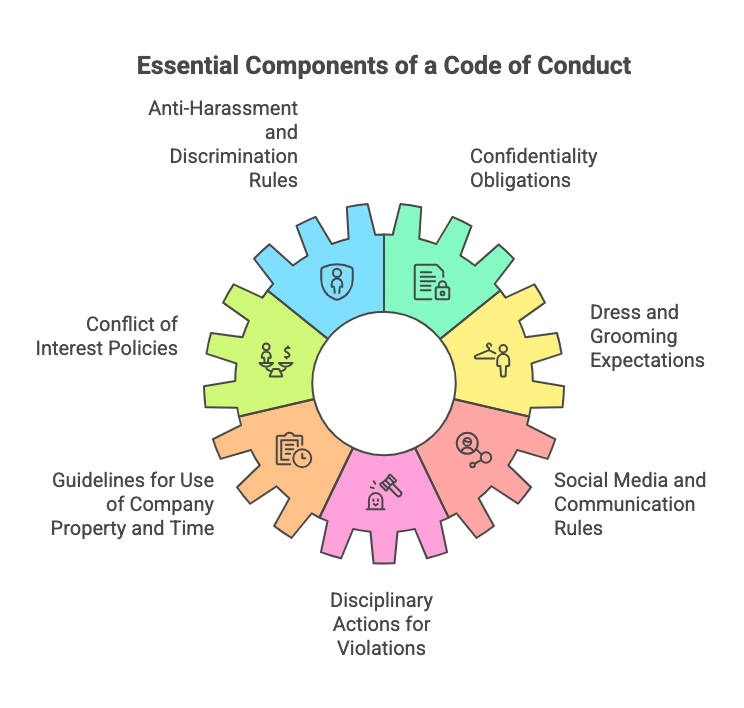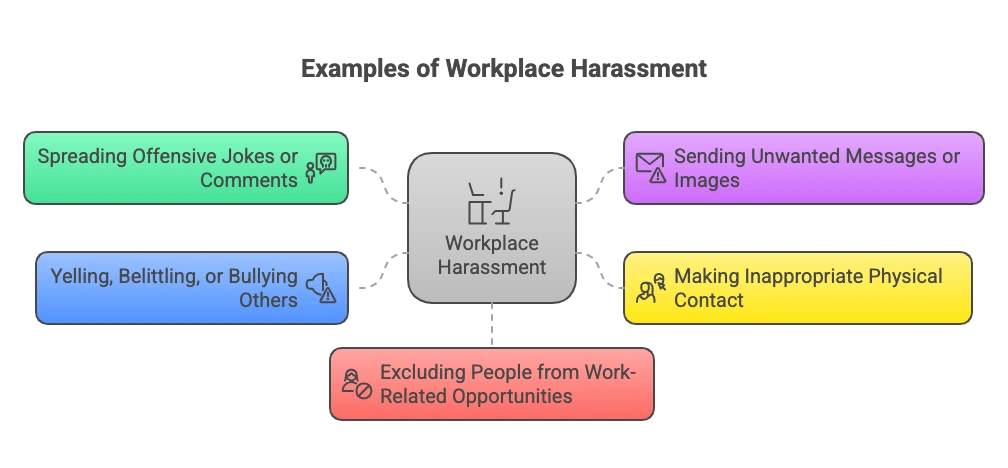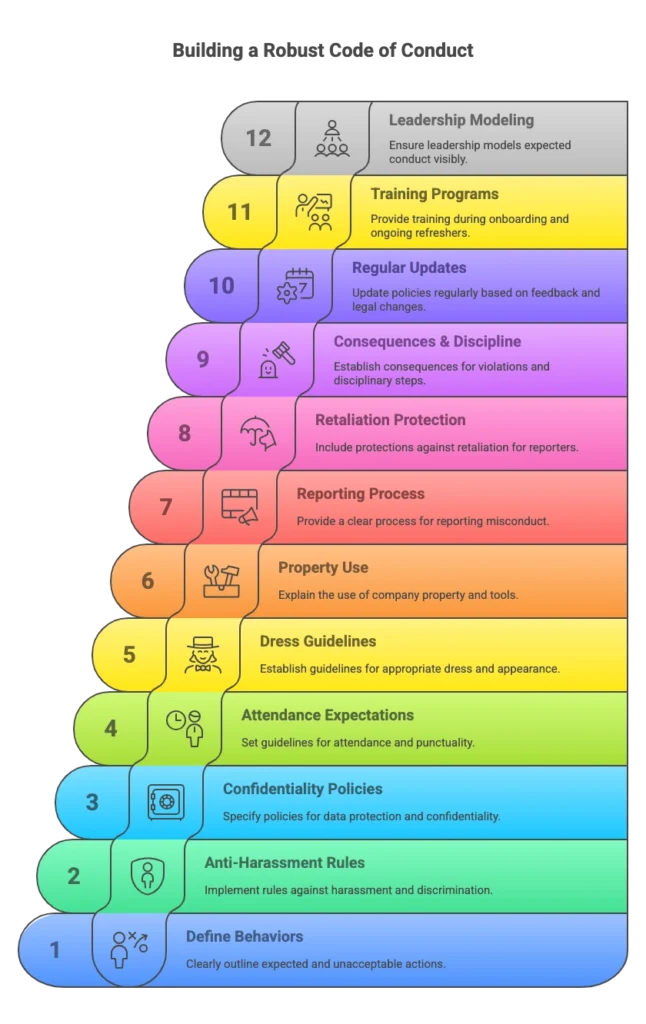Workplace conduct is how employees behave on the job. It includes communication, collaboration, ethics, and rule-following. Every task, meeting, or email reflects it.
Why does it matter? Because toxic conduct destroys morale. Poor behavior ruins productivity. Violations invite lawsuits. When conduct is right, everything flows—trust, accountability, results.
This article cuts through the noise. It breaks down what workplace conduct means. You’ll see how it differs from policy. You’ll get real examples—both good and bad. We’ll look at codes of conduct, legal standards, and the line between rude and illegal.
We’ll also examine federal guidelines, court system expectations, and the Equal Employment Opportunity laws that govern behavior at work. Finally, you’ll learn how HR and leadership can create environments where misconduct is rare—and where reporting is safe.
what is workplace conduct?
Workplace conduct means how people act at work. It covers what they say, how they behave, how they treat others, and whether they follow rules. It includes punctuality, communication, attitude, ethics, and decision-making. Conduct applies across roles, industries, and job levels.
Some call it “professionalism.” Others refer to it as “behavior.” But conduct is broader. It’s what you do when nobody’s watching. It’s how you handle pressure, disagreement, success, or power.
why it matters in every industry
Bad conduct ruins teams. It leads to gossip, favoritism, missed deadlines, and lawsuits. It slows productivity and kills morale. One toxic employee can drive away five great ones.
Good conduct keeps people focused. It builds respect, trust, and momentum. Whether you’re in healthcare, construction, retail, or finance, conduct shapes everything—customer service, coworker relationships, and company culture.
Workplace conduct vs. workplace policy
Don’t confuse conduct with policy. The policy is written. Conduct is lived.
The policy says “no harassment.” Conduct is how you speak to a new intern.
The policy says, “Respect work hours.” Conduct is whether you answer messages at 2 AM or protect your team’s time.
Conduct reveals what values guide your workplace.
What is workplace conduct in short?
Workplace conduct refers to how employees behave on the job, including their ethics, communication, decision-making, and compliance with rules and norms. It directly affects morale, productivity, and legal risk.
Types of workplace conduct
Workplace conduct isn’t one thing. It spans multiple areas—ethical, professional, legal, and interpersonal. Each shapes how people interact, make decisions, and represent the company.
Ethical conduct
This is doing what’s right, even when nobody’s watching. It means telling the truth, owning your mistakes, reporting misconduct, and refusing shortcuts that break trust. Ethics guide decisions. They influence how you treat data, money, clients, and teammates.
Professional Conduct
Professional conduct means acting with discipline. It includes being punctual, meeting deadlines, dressing appropriately, keeping personal issues out of work, and handling stress without creating drama. It’s how you show you’re dependable.
legal conduct
Legal conduct means following the law—labor laws, safety codes, anti-discrimination regulations, and confidentiality agreements. One slip can trigger lawsuits, fines, or criminal charges. Following the law isn’t optional. It’s the minimum standard.
Interpersonal conduct
This covers respect, empathy, communication, and inclusion. It shows up in meetings, Slack messages, and hallway chats. Interpersonal conduct makes teams work—or fall apart. It determines whether people feel safe, heard, and valued.
examples of strong workplace conduct
- meeting project deadlines without reminders
- using inclusive, non-derogatory language
- keeping client information confidential
- showing up prepared and on time
- respecting coworkers’ focus time
Comparison table: professional vs. ethical vs. legal conduct
| type | what it focuses on | example of good conduct | consequence of failure |
| professional | reliability, attitude, discipline | delivering work on time | damaged reputation, poor reviews |
| ethical | honesty, fairness, responsibility | refusing to cover up a teammate’s fraud | loss of trust, internal sanctions |
| legal | laws, regulations, compliance | following HIPAA rules in healthcare | lawsuits, fines, termination |
Code of conduct in the workplace
A code of conduct isn’t optional. It’s the document that sets behavioral expectations for everyone—new hires, senior leaders, contractors, interns. It defines the boundary between acceptable and unacceptable behavior. Without one, enforcement becomes arbitrary. With one, the rules are clear.
what is a code of conduct?
A workplace code of conduct is a written set of rules and values. It tells employees what behavior the company expects and what it won’t tolerate. It includes practical policies and sets the moral tone.
It’s not just HR paperwork. It’s the standard that shapes daily decisions, team culture, and how problems get handled.
Key elements of a standard code
A strong code of conduct includes:

- anti-harassment and discrimination rules
- confidentiality obligations
- conflict of interest policies
- dress and grooming expectations
- Guidelines for the use of company property and time
- Social media and communication rules
- disciplinary actions for violations
The best codes use clear language. They don’t bury expectations in legal jargon. Every employee should understand what’s required on day one.
examples of common policies
- dress code: wear clothing appropriate to the work setting—formal, casual, or informal
- anti-harassment: zero tolerance for sexual, verbal, or physical harassment
- confidentiality: protect sensitive company data, customer information, and internal discussions
- attendance: report on time, notify absences, log hours accurately
- Internet use: don’t browse offensive content, download pirated files, or share login credentials
Benefits for employers and employees
For employers, a code reduces legal exposure and helps enforce standards consistently. For employees, it creates clarity. Everyone knows what’s expected and where the boundaries are. That stability protects team morale and makes onboarding faster.
Without a code, conflict resolution turns messy. With one, enforcement becomes simple: show the policy, and apply it equally.
Workplace Harassment and Misconduct?
Some behavior crosses the line. It’s not just annoying or unprofessional. It’s harassment. It’s misconduct. And it creates real legal and emotional consequences. Every employer must know the difference—and act fast.
what counts as misconduct?
Misconduct refers to behavior that violates company rules or legal standards. It includes bullying, verbal abuse, discrimination, sexual harassment, retaliation, and any action that makes someone feel unsafe or targeted.
Minor offenses—like repeated lateness—might lead to warnings. Major offenses—like threats or harassment—can lead to immediate termination.
examples of workplace harassment
- Spreading offensive jokes or comments
- Sending unwanted messages or images
- making inappropriate physical contact
- yelling, belittling, or bullying others
- excluding people from work-related opportunities based on race, gender, or religion
EEOC guidelines:
The Equal Employment Opportunity Commission (EEOC) defines harassment as any unwelcome conduct based on protected characteristics such as race, color, sex, religion, national origin, age, disability, or genetic information. According to EEOC.gov, for harassment to be unlawful, it must create a hostile or offensive work environment or result in an adverse employment decision (like being fired or demoted).
The role of HR and compliance:
HR must act fast. Delayed action increases liability. When a complaint is raised, HR must document it, investigate it, and take corrective steps. All reports must be kept confidential. The goal is safety and fairness, not punishment alone. Compliance teams, legal advisors, and senior leadership should stay aligned. Policies are useless if leaders look the other way.
Preventing retaliation:
Retaliation is when someone gets punished for reporting misconduct. It’s illegal. Firing, demotion, threats, or even social exclusion after a complaint can qualify. Organizations must train managers not to retaliate and monitor for it. Retaliation kills trust faster than the original incident.
Federal and Legal Guidelines for Workplace Conduct?
- Some workplace rules are optional. Legal standards are not. Employers in the U.S. must follow federal laws that govern how people are treated on the job. Ignoring them leads to lawsuits, investigations, fines, or even shutdowns.
- Federal guidelines apply to government agencies and private companies. But enforcement may differ. Federal employees must also follow special codes, like the U.S. Judiciary’s workplace conduct policy. Private companies build their policies, but they can’t override federal law.
- The U.S. Courts follow strict behavioral standards. According to uscourts.gov, all judicial employees must work in environments free from discrimination, harassment, abuse of authority, and retaliation. Misconduct gets reported through formal procedures and is handled with urgency.
- Managers in the court system receive mandatory training. That’s not just policy—it’s practice. Other sectors can learn from that level of enforcement.
- EEO laws protect people from discrimination based on race, gender, religion, disability, age, or national origin. They apply at the hiring, promotion, job assignment, training, and termination stages.
- Violating EEO laws opens companies to legal claims handled by the EEOC. These are not rare. Thousands of harassment and discrimination claims are filed every year.
legal consequences of misconduct
Legal violations aren’t just internal problems. They can lead to:
- lawsuits from former or current employees
- investigations by state or federal agencies
- financial penalties or settlements
- permanent reputation damage
- employee turnover due to unsafe environments
Ignorance of the law isn’t a defense. Managers and HR teams need legal literacy. Every new leader should get trained on what crosses the legal line—because one mistake can cost millions.
Real-world examples of good and bad conduct
Workplace conduct isn’t theory. It plays out every day in clear actions—positive and negative.

Positive examples
Teams that collaborate openly deliver better results. Sharing information transparently avoids misunderstandings. Showing up on time signals respect for others’ schedules and keeps projects on track. These actions build trust and efficiency.
Negative examples
Gossip spreads rumors and breaks down team cohesion. Habitual lateness delays meetings and frustrates coworkers. Discrimination—whether overt or subtle—creates unsafe environments and violates laws. These behaviors lower morale and increase turnover.
comparison table: good vs. bad workplace conduct
| Good conduct | Bad conduct |
| collaborating across teams | excluding coworkers from meetings |
| sharing progress honestly | hiding mistakes or info |
| arriving punctually | repeated lateness |
| using respectful language | offensive jokes or slurs |
| respecting diversity | discrimination or bias |
Positive conduct supports productivity and legal compliance. Negative conduct creates risk and damages culture. Every organization must recognize these clear examples and act accordingly.
Why Workplace Conduct Policies Fail?
Policies don’t enforce themselves. Many fail because organizations ignore key factors.
- Lack of enforcement is the biggest problem. A policy on paper means nothing without consistent consequences. Vague or outdated guidelines confuse employees instead of guiding them. Without clear rules, people guess what’s acceptable
- Training is often too rare or superficial. Employees don’t learn how to apply policies in real situations. Without proper training, misconduct slips through.
- Many companies lack a clear reporting framework. Employees don’t know how or where to report issues or fear retaliation if they do.
- Ignoring violations breeds resentment, mistrust, and higher turnover. Legal risks increase as problems escalate unchecked. Small issues grow into crises.
How to audit and revise policies
Regular reviews are essential. Talk to employees and managers. Analyze complaints and outcomes. Update rules to reflect new laws, technology, and workplace norms.
Only policies backed by clear enforcement, training, and reporting systems will succeed.
How to Improve Workplace Conduct in Your Organization?
Good conduct starts with clear expectations.
- Document behavioral standards in easy-to-understand language. Share these during onboarding. Don’t assume people know what’s allowed or not. Early clarity prevents confusion later.
- New employees should conduct training as part of their first week. Use real scenarios, quizzes, and role plays to make it practical. Reinforce why conduct matters—not just rules, but workplace culture and success.
- Conducting training isn’t one-and-done. Regular refreshers, team discussions, and updates keep behavior top of mind. Leadership must model good conduct consistently. Actions speak louder than memos.
- Set up channels where employees can safely report concerns. Encourage peer feedback. Use HR software to track patterns and flag issues early. Accountability reduces repeat offenses and builds trust.
- Clear documentation, active leadership, and technology help turn conduct policies from words on paper into real workplace behavior.
Building a Positive Work Culture Through Conduct Next?
Workplace conduct shapes culture. Culture shapes results.
- Aligning values with behavior: Organizations must define core values and live by them. When behaviors match values, trust grows. Employees feel secure knowing what’s expected and rewarded.
- Trust, empathy, and communication: Trust doesn’t happen by chance. It’s built through honest communication and respect. Empathy allows teams to handle conflict without escalation. Conduct that fosters these traits creates safer, more productive workplaces.
- Inclusion and psychological safety: A positive culture embraces diversity and ensures psychological safety. Employees can speak up without fear of judgment or retaliation. Inclusion isn’t just fair. It improves innovation and engagement.
- Rewards and recognition: Rewarding good conduct reinforces it. Recognition programs for teamwork, respect, and integrity motivate others to follow suit. Positive peer influence can shift entire workplace norms faster than top-down rules.
Examples from high-performing companies
Companies like Google and Salesforce emphasize clear conduct standards tied to culture. They back this with transparent feedback and robust training. The result: high retention, low harassment claims, and strong employee satisfaction.

conclusion
workplace conduct defines how organizations function. strong conduct boosts morale, drives success, and reduces legal risks. ignoring it invites conflict, turnover, and lawsuits.
employers must set clear standards, enforce them consistently, and train teams regularly. employees play a role by modeling respect, honesty, and professionalism every day.
use this guide to build or improve your workplace conduct policies. download the free code of conduct checklist to get started. strong conduct isn’t optional—it’s essential. If you want, I can also help draft the downloadable checklist or template next.




